Geographic mental maps as ways and forms of
organizing mental representations of space [1, 2] are of interest for
a wide range of scientific disciplines since they reveal the humans’ receiving,
processing, storing, and broadcasting of individual ideas about the world. From
a social point of view, geo-mental maps provide models for
understanding/mastering the spatial macroenvironment and the behavior of
various social groups in that environment, while the groups are distinguished
by gender, age, nationality, residence region, etc. [3–5].
To efficiently analyze the mental maps, an
adequate representation form should be chosen to convey the composition,
metrics, and connections of objects contained in mental maps. In this regard,
the most promising way is the visualization of informants’ subjective
geospatial representations. This visualization can be carried out in the
paradigm of “naive” geography: in the form of the so-called “naive” maps
(another term “sketch maps” is also common [6, 7]). M. Blades
has shown that naive maps have the feature of sustainable
reproduction [8], which means that the same informant draws nearly the
same naive map time after time. This indicates, naive maps are an adequate
reflection of mental maps, therefore they can be treated as an objective
measure of an informant's attitude to his/her spatial surrounding. As a result,
naive maps are valuable material for the Digital Humanities research, allowing
to monitor and justify the public moods in a particular region or social
group [1, 3], as well as to study individual cognitive features of
informants and the way they perceive the world around them.
Traditionally, the naive maps are drawn on
paper. This is quite convenient for the informants, but it has two significant
drawbacks. Firstly, in order to benefit the modern computational processing
methods, the paper-drawn maps should be completely digitized (including the
annotating of all available objects on each map). Secondly, it is required to
normalize the drawing process, including the use of standardized technical and
symbolic means. The variety of representation forms of naive maps can be
clearly seen in the gallery of regional maps of Russia:
https://naivemaps.ru/?page_id=395.
It is a challenging task to handle these images, while fully
automatic processing and interpretation for a sake of data mining are nearly
impossible. Moreover, paper-drawn naive maps do not contain information about
the process of their creation, including the sequence of adding objects and
their characteristics.
To overcome the shortcomings mentioned
above, we developed the Creative Maps Studio web application
(https://creativemaps.studio/).
This application is a web-based vector graphics editor, in which
informants visualize their spatial representations in a form of digital naive
maps using the predefined set of drawing tools. For the experts in Digital
Humanities, the Creative Maps Studio provides functions to export naive maps
composed by the informants for subsequent data mining and visual analytics. The
analytics is performed outside of Creative Maps Studio, in the SciVi data
mining platform and Semograph graph-semantic modeling information system. These
two software systems were developed earlier and proved to be efficient and
flexible in analyzing complex data [9]. Creative Maps Studio can be used
by researchers from various fields of science, such as sociology, politology,
tourism-related sciences, etc.
In this paper, we propose a special vector
graphics editor to create digital naive maps, as well as the following ways to
analyze these maps within a remit of Digital Humanities research:
1.
Analysis of
the naive map creation history using Creative Maps Studio. All the
manipulations with maps’ objects in chronological order can be viewed,
which enables studying the process of building the map, including the
tracking of objects, which were created, but afterward deleted and thereby
not presented in the final map state.
2.
Visual
analysis of naive maps in SciVi data mining platform using a circular
graph that allows revealing relationships between map objects, as well as
correlations between maps’ structure and socio-cognitive parameters of the
informants.
3.
Semantic
analysis of naive maps using the Semograph graph-semantic modeling
information system. This opens up the possibility of automated analyzing
names, descriptions, and comments of map objects.
4.
Fuzzy
classification of naive maps based on weighted fuzzy pattern matching.
This method makes it possible to quantify the features of the spatial
perception of informants from different regions and to test the similarity
of the given map with the typical maps of a certain region.
The first studies of mental maps emerged in
the second half of the 20th century and were carried out using naive
maps [10, 11]. For a long time, research was carried out without the
use of computer technology. Naive maps drawn on paper were used and,
accordingly, the analysis was also carried out manually [12–14]. At the
same time, naive maps were often not the only source of information for
research: in addition to the maps, informants also completed pre-designed
surveys and face-to-face interviews or participated in focus
groups [15, 16]. The processing and analysis of the results were
carried out in manual mode.
Later, research began to be carried out
using computer technology. In particular, in 1984, S. Waterman and
D. Gordon used a computer to calculate the degree to which a digitized
naive map matched an objective geographic map of Israel based on a set of
control points [17]. F. Aram et al. describe a more
comprehensive approach to the analysis of naive maps considering a set of
landmarks and paths, which were marked on the maps by informants. Objects are
analyzed from two aspects: location accuracy and map complexity. Accuracy is
determined by the degree of correspondence between the sets of landmarks and
paths, marked by informants, with the sets predetermined by experts. The degree
of correspondence is determined by the percentage ratio of the number of
objects from the expert list found on the naive maps of informants to the
length of the expert list. Complexity is measured using the cell percentage
method and based on Appleyard’s scoreboard. The program proposed by
Aram et al. makes it possible to both compare the naive map with the
one created by the experts (or with another naive map) and get the reflection
of information from all the informant maps to the objective geographical
map [18]. However, despite the fact that the analysis of the maps was
carried out on a computer, the creation of the maps took place on paper.
Most researchers distinguish three main
components in naive maps: lines, points, and zones [18]. Indeed, when
creating a two-dimensional map, any object can be represented by one of these
three components or their combination. In some cases, informants draw 3D naive
maps. However, such maps are usually analyzed when the dimensions of the
investigated space are comparable to the heights of objects. Accordingly, when
the object of study is a relatively large geographic area, it is possible to
neglect information about the heights of objects and use a two-dimensional
space. The methods used for processing naive maps depend on the dimensions of
space.
When the sample of maps is small enough,
then usually the research is carried out at a qualitative level and ad-hoc
methods are used. Otherwise, one or more of the basic approaches to map
analysis are used. One of these approaches is based on comparing naive maps
with a real geographical map. Another approach is to compare the maps of
informants with each other to identify some trends. A combination of these
approaches is sometimes used [19].
The basic element for comparison in these
cases is a set of landmarks on the map. On a global scale, such landmarks can
be, for example, settlements, state borders, seas, mountain ranges, etc.
The choice of comparison methods depends on
the form of data presentation. When objects are deterministic, it is convenient
to use the bidimensional regression method, which makes it possible to compare
two two-dimensional objects with each other [20]. A naive map can also act
as an object. A. L. Gardony et al. used, in addition to the
bidimensional regression method, the method of pairwise comparison of
landmarks [21]. At the same time, the initial naive maps are created on
paper and, accordingly, are analyzed visually. If the pattern or naive map is fuzzy,
it makes sense to use methods of fuzzy classification of objects. One of such
methods is the weighted fuzzy pattern matching [22]. Although it is used
in its original form to compare fuzzy numbers, it can be applied to compare the
corresponding numerical parameters of a naive map and a pattern.
We propose the Creative Map Studio, which
provides tools for creating and analyzing naive maps. Maps created in this
application are digital, and they can be analyzed without manually marking the
landmarks. The objects created in the studio have meta-information not inlined
on the map. So, they can be verbally described preserving the clean
visualization of the map. In addition, the naive maps created in this
application store both the final state of the map and the history of its
creation.
The analytics available for the maps drawn
in Creative Map Studio relies on SciVi data mining platform [23] and
Semograph graph-semantic modeling information system for textual data
processing [24]. Both of these software systems were created in our
previous research and proved their abilities of an efficient and comprehensive
analysis of complex and variable data [9].
SciVi data mining platform
(https://scivi.tools)
is built on the principles of ontology engineering. Its
functioning is completely governed by an ontological knowledge base, in which
all the data processing, analysis, and visualization capabilities are
described. Thereby, SciVi is a very flexible toolset for solving analytics tasks
in different application domains because it can be extended with the new
functionality by modifying its knowledge base only [25]. The data
processing pipelines in SciVi are declared in a high-level graphical user
interface leveraging intuitive visual programming language based on data flow
diagrams [25]. SciVi usage requires no specific IT skills, which makes
this platform available for a wide range of experts in different scientific
fields.
The Semograph graph-semantic modeling
information system
(https://semograph.com)
is built on the principle of data representation in the form of a
graph, which vertices reflect the semantic cores of concepts, and edges
characterize the semantic connections between concepts. The essence of its
functioning is that the data loaded for analysis are divided into some semantic
parts (such as book chapters, individual objects within the dataset, etc.).
These parts are called “contexts”. Within each context, “semantic fields” and
“semantic components” are distinguished. Semantic fields are lexemes or
combinations of lexemes. Semantic components are the entities associated with
the fields, which reflect the presence of certain semantics in the
corresponding fields. Semograph has a high-level graphical user interface with
which the user can both manually and automatically work with text data,
studying their semantic properties. Analyzing textual data based on semantic
fields and semantic components reveals its semantic structure that is an important
part of linguistic research [26, 27].
Creative Maps Studio is a client-server web
application designed to work with naive maps representing spatial mental maps.
The main concepts of Creative Maps Studio architecture are presented in a form
of ontology in Fig. 1.
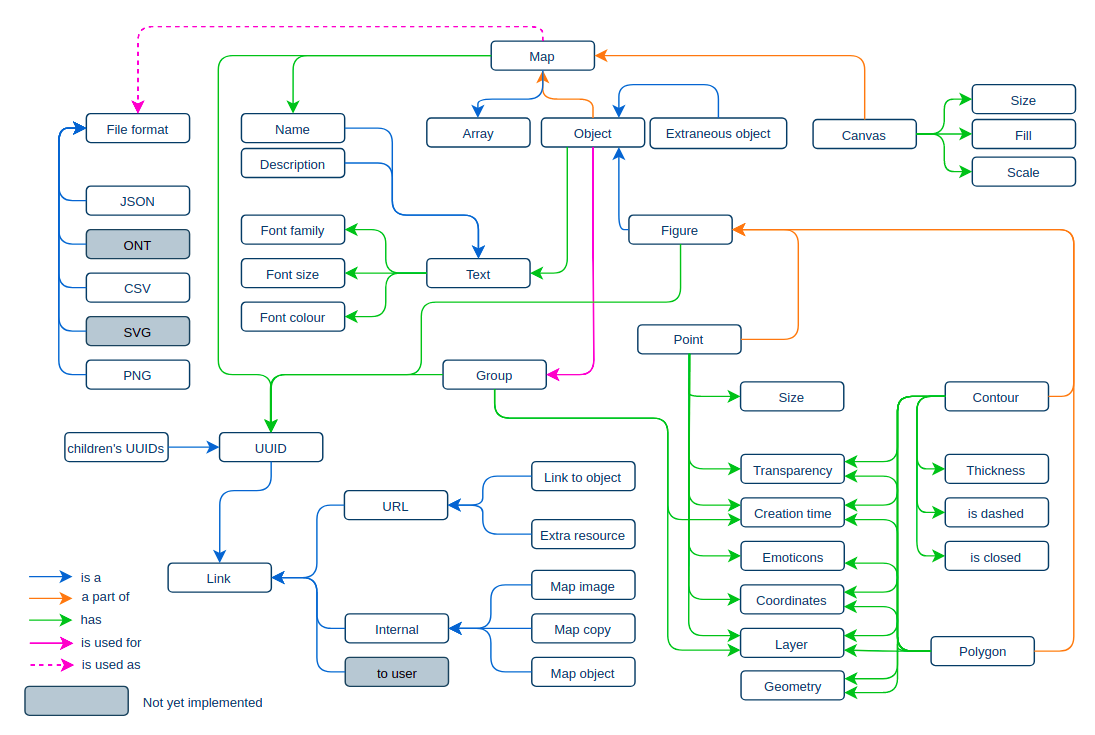
Fig. 1. Ontology of Creative Maps Studio
With the help of
Creative Maps Studio, the informant can digitally draw a geo-mental
representation of a certain space, which reflects a mental map of his/her
spatial perception. A mental map is a complex object that represents a certain
geo-concept and contains a set of graphical objects with their verbal
descriptions, which characterize the informant’s subjective attitude to space.
The physical representation of a mental map is a naive map. On the one hand, a
naive map represents geographical objects as some spatial entities, which can
be studied using various analytical methods, and as a result, give some
semantic interpretation of the location and parameters of objects. On the other
hand, geographical objects contain a text layer that makes it possible to
highlight the informant’s attitude to objects and allows researchers to match
the drawn objects with the real ones and identify the depicted space, that is,
to determine the map’s belonging to some geo-concept (or a combination of
geo-concepts).
In addition, the
informant can provide information about himself. Such information makes it
possible to investigate differences in the content or presentation form of
mental maps based on some characteristics of the informants, such as gender,
region of residence, etc.
The Creative Maps
Studio is available at
https://creativemaps.studio.
Moving on to the technical aspects of its functioning, we note
that maps are internally stored in JSON format and can be exported to CSV
tabular format and raster PNG format. While Creative Maps Studio stores the map
objects with the full history of creation and manipulations, when exporting to
CSV, only the final states of the objects are dumped. If some specific data
conversion is required, additional conversion modules are used. The modules are
written in Python and executed on the server side as processing plugins. For
example, plugins are used to normalize parameters among a sample of maps.
The server side of Creative Maps Studio
consists of the following components: main module (written in Python 3 using
FastAPI), storage module (based on PostgreSQL), and caching module (based on
Redis). The client side is implemented in JavaScript using React, Redux, and
Gatsby using HTML5 templates and CSS3 styling.
The
architecture diagram is shown in Fig. 2.
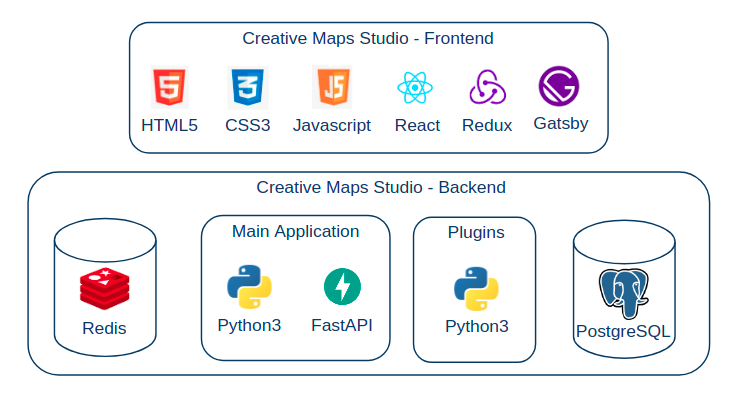
Fig. 2. Creative Maps Studio architecture
diagram
The server provides the following
functions:
1.
Authorizing
and registering the users directly in the application and log in with
their credentials, or log in to the application via their profile on the
following social networks: ‘ÂÊîíòàêòå’ (Vkontakte), Facebook and ‘Îäíîêëàññíèêè’ (Odnoklassniki).
2.
Storing the
maps drawn by the user and providing access to them (but users can also
draw maps anonymously and save these maps at their computers).
3.
Providing
access to copies of maps drawn by other users by direct links.
4.
Performing
requests to third-party resources:
a.
Database of
settlements in Russia.
b.
Social
networks, through which users can log in to the studio and in which they
can share maps they have drawn.
The client provides the tools for creating
and editing maps. It is possible to arrange the following types of objects on
the map: point objects such as cities, cultural monuments, and industrial
objects; large-scale objects such as bodies of water, deserts, and swamps;
extended objects such as state borders, roads, and rivers. Objects can be given
individual visual characteristics, as well as a verbal name and description.
Additionally, it is possible to indicate attitude to the objects using
emoticons. Drawn maps contain not only the final state of all objects but also
the history of all manipulations with objects performed during drawing. The
manipulations’ history allows researchers to analyze the process of creating a
map. In addition, in the studio client, the user can receive training on
working in the studio or refer to the help on using it.
Since naive maps are presented in graphical
form, they can be created both on a physical medium, for example, on paper, and
in a digital form. Let us compare digital and paper-drawn naive maps.
Firstly,
let us look at the advantages of digital naive maps over paper-drawn ones:
1.
Objects on
digital maps can be interpreted with higher accuracy than on paper-drawn
ones: digital maps have limited variation in their parameters, so they can
be better classified and have no issues with recognition of handwriting.
2.
Digital maps
can be analyzed automatically (no conversion to the digital format is
needed).
This is especially important for large map
arrays.
3.
Digital maps
contain easily retrievable text information (names, descriptions,
emoticon-based expressions about objects) without compromising the
visualization of map objects. This is difficult for paper-drawn maps,
where all the text must always be visible on the map.
4.
Digital maps are
easier to store and back up: they take up a small amount of space on the
digital storage and can be copied fast and losslessly, while paper-drawn
maps require large physical storage with special conditions like
temperature and humidity, as well as require much more time and effort for
backup.
5.
Digital maps
are created online thus remotely, allowing researchers to involve
geographically distant informants.
6.
Digital maps
make it easier to attract informants to participate in the study since it
is more convenient for the informants to draw from home at any time (while
the study is being carried out) than to come to the laboratory at a
designated time or to transfer the physical map medium in any physical
way, or digitize it and send it per e-mail.
7.
Digital maps
make it possible to overlay objects on top of each other without
distorting or losing information about any of them, which allows
researchers to get more information from a digital map than from a
paper-drawn one.
8.
Digital maps
are able to save the history of the informant’s actions in the drawing
process, which is nearly impossible to achieve when using paper-drawn
maps.
However, despite all the advantages of
digital maps over paper-drawn ones, digital maps also have disadvantages:
1.
Working with
paper is more familiar to most of the informants since most users are
better at using the tools for traditional drawing (for example, a pencil)
than a mouse/touchpad. As a consequence, digital maps usually have less
detail and complexity of the contours of objects.
2.
Working with
digital tools to create digital maps requires training that allows the
informants to get used to the interface. If the training time is
insufficient or the interface is too complex, there is a high risk of
receiving less information from the maps, since informants will not know
how to create objects they want.
3.
Drawing a
digital map is limited by the set of drawing tools. Informants may want to
display an object that has not been accounted for by the researchers. In
this case, the object may not be reflected on the map, reflected
incorrectly (using a tool that does not imply such interpretation), or
displayed too abstractly.
Based on the above comparison, we conclude
that in most cases digital maps are preferable for building naive maps.
Creative Maps Studio allows to benefit from all the above advantages of digital
maps, thus it is an adequate toolset for conducting corresponding experiments.
As for the disadvantages, the first of them is currently assumed to be
impossible to overcome in the short term. The second one can be tackled by the
detailed help for the studio and the built-in learning mechanism. The influence
of the third one is supposed to be gradually reduced using feedback from
informants and adding missing object types.
We handled paper-drawn maps in our previous
research in the Digital Humanities field and we can state that maps in this
form are difficult to collect and analyze, in particular, it is difficult to
extract and process the related textual information [2]. Therefore we believe
that the use of digital maps can improve the research process and deepen the
data analysis.
We propose the following ways to analyze
the mental maps represented as naive maps:
1.
Viewing the
map and the process of its creation in Creative Maps Studio (an example is
shown in Fig. 3 and available at
https://creativemaps.studio/share?share_token=eyJ1dWlkIjoiZjA5MjgyMjYtNGNlYi00MTVjLWI4M2UtY2ExNjYyMTcxZGYyIiwidm Vyc2lvbiI6MSwidGl0bGUiOiLQndC-0LLQsNGPINC60LDRgNGC0LAifQ.sapGTjAquMSAlng5Xb QW-1DODjU).
2.
Visual
analytics of maps’ set in the SciVi data mining platform.
3.
Visual
analytics of the maps’ text layers in the Semograph information system.
4.
Fuzzy
classification of naive maps using SciVi.
Further, we will take a
closer look at the analytical approaches used by SciVi and Semograph systems.
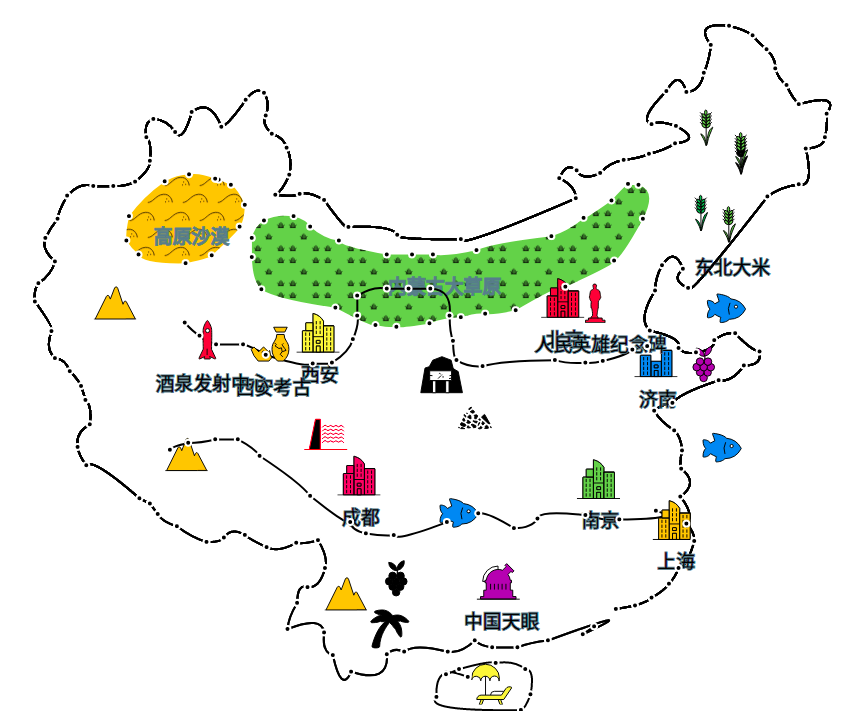
Fig. 3. An Example of a naive map of China
drawn in Creative Maps Studio
One way to analyze naive maps is to handle
them in SciVi. To do this, the parameters needed for analysis are selected from
the source maps drawn by the informants, exported to CSV, and loaded into
SciVi, where the subsequent analytics pipeline is visually declared using data
flow diagrams [25].
As an example of this approach, we studied
a set of China maps drawn by 100 students of 2 Chinese universities. A table of
the different use colors for some Chinese cities was considered. In this case,
the color and name of the city were selected as target parameters to build an
aggregated table of maps. However, it is possible to analyze any combination of
parameters of objects on the map.
Accordingly, on the SciVi side, a file with
information from the maps is fed to the input, and the nodes responsible for
the rendering method are selected. In our case, a circular graph is used.
Fig. 4 shows the SciVi data flow diagram that allows the input CSV file to
be visualized as a circular graph.

Fig. 4. SciVi data flow diagram
Executing this data flow diagram, SciVi
displays a circular graph that shows which colors are used for each of the
cities that the informants drew on their maps. Fig. 5 shows an example of
such a circular graph. The color diversity is clearly seen in the graph, while
Beijing is most often drawn red.
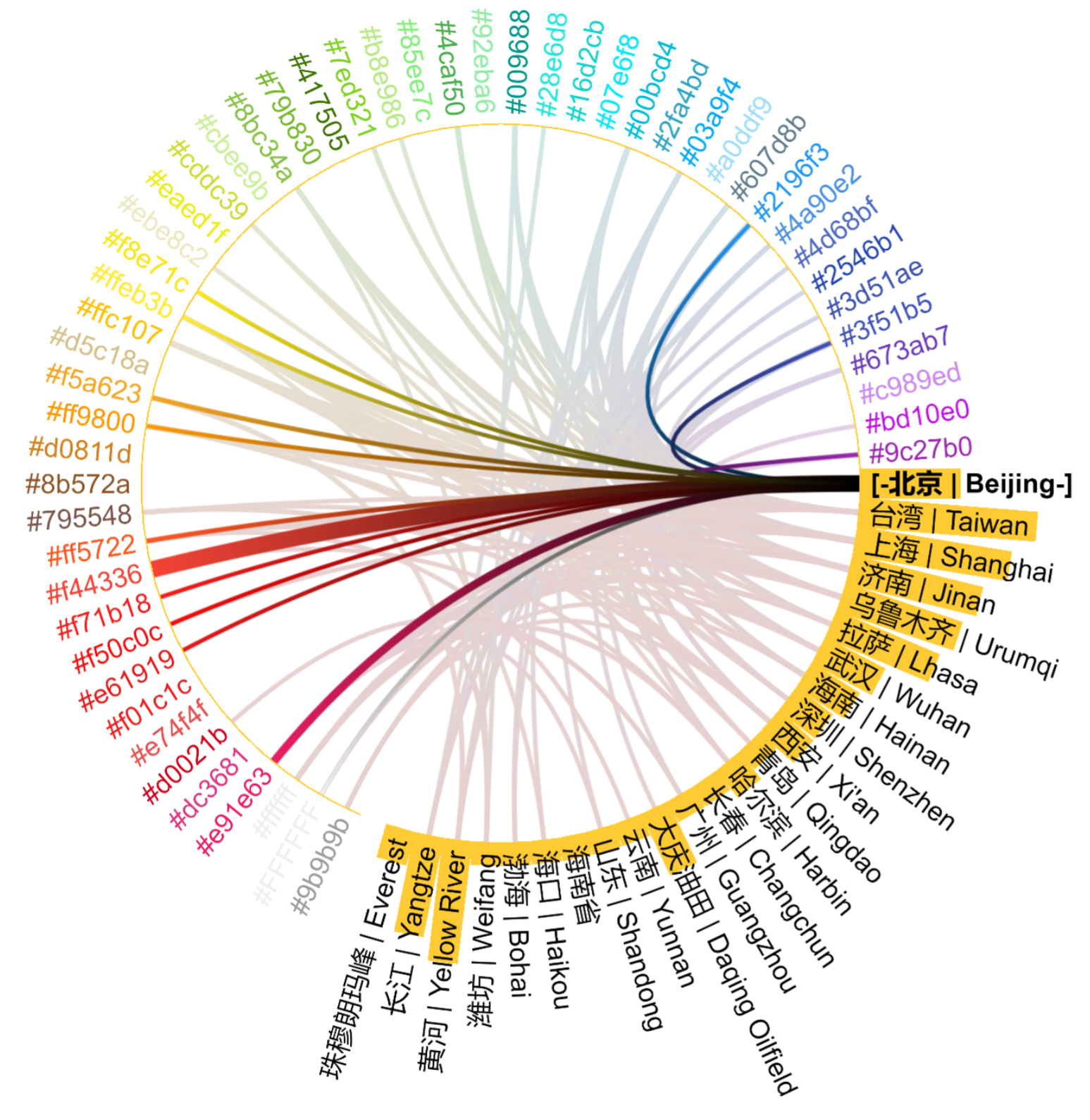
Fig. 5. SciVi Circular graph of using different colors for some
Chinese cities
Semograph analyzes
the textual components of maps, therefore, the main target in such a study is
in the analysis of names, descriptions, and emoticons related to the map
objects. Accordingly, after loading, Semograph prepares data as follows. The
first step is splitting the file into contexts (each context is one map from
the file). Within each context, semantic fields (lexemes or their combinations)
and semantic components are distinguished. Semantic components are associated
with fields and reflect the presence of certain semantics in them. The
preparation of the textual data of maps can be carried out by an expert in
manual mode, using machine learning methods, or using a combination of these
approaches.
After the Semograph has made the primary
processing of information from the file, a semantic map is drawn up, which
quantitatively reflects the connections between semantic fields. The semantic
map can then be visualized by means of the SciVi system in the form of a
semantic graph, which makes it possible to visually evaluate the semantic
relationships of the semantic fields. Fig. 6 shows an example of a graph
representing the semantic structure of the Beijing geo-concept. This geo-concept
was reconstructed according to the text layers of the set of China maps (the
map collection is the same as described in Section 6.1). In the graph
shown in Fig. 6, nodes depict the most frequent terms characterizing the
Beijing geo-concept and edges depict the simultaneous appearance of
corresponding terms within a text layer of the same map. This kind of
graph-based visualization allows experts to reveal interesting regularities in
the semantic structure across different geo-concepts. For example, it was found
out that the Chinese students indicate all the country locations rather
positively, expressing quite nothing negative. However, such geo-concepts as
Beijing and Shanghai have a much reacher semantic structure than Taiwan that is
represented poorly.
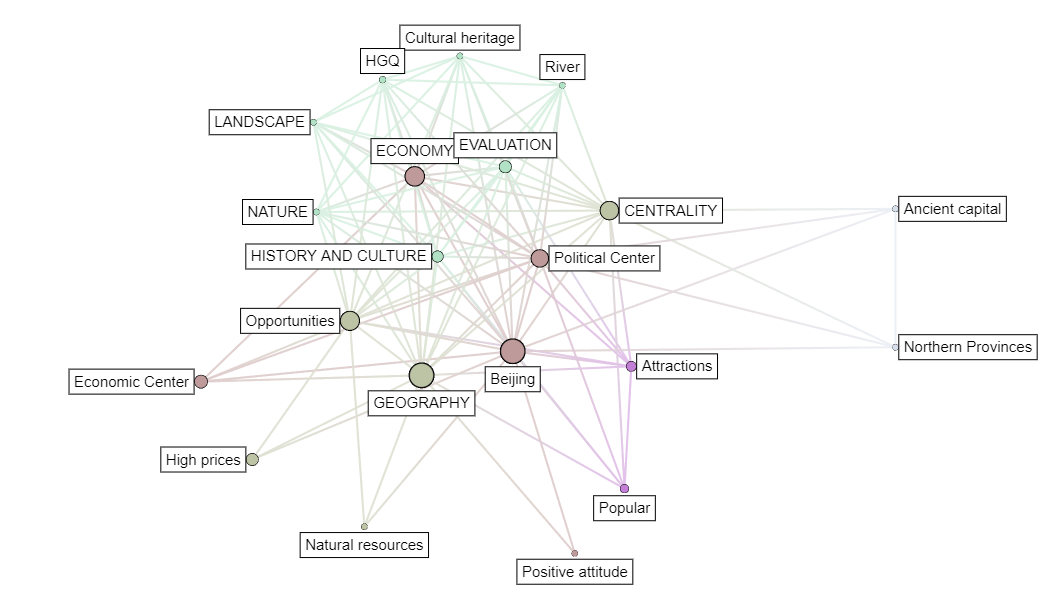
Fig. 6. SciVi semantic graph
of Beijing geo-concept
The fuzzy classification described in this
paper is based on the algorithm of weighted fuzzy pattern matching presented
in [22]. The described algorithm was implemented as a SciVi plugin written
in JavaScript.
Since the algorithm
uses a system of weights for the parameters, a weight vector is also compiled
before starting. The values of each of the weights are determined based on the
importance of the corresponding parameters, as well as taking into account the
spread of their values in the set of maps (the smaller the spread, the less
weight should be assigned to the parameter in order to avoid anomalous
influence on the classification results).
The preprocessed maps are loaded into SciVi
in two parts. The first part contains maps, drawn by informants with known
regions of residence. These maps represent patterns that characterize different
regions. A region pattern is a set of such objects that are found on the maps
of the informants from this region. In this case, the parameters of the pattern
objects are fuzzy values. The membership function of a certain parameter of a
certain object is built according to the values of this parameter for this object,
found on different maps of a given region (for details, see [28]). In
terms of machine learning, this set of maps is treated as a training sample.
Along with the training sample, a vector of parameter weights is provided. The
second part of the maps is a set of maps, drawn by informants with unknown
residence regions (the test sample of maps). This set of maps is classified.
Next, SciVi performs pattern building and
then sequentially compares each test map with each pattern [28]. According
to the results of the classification, a dictionary of the correspondence
degrees to each of the patterns is found out for each test map. The highest
degree of pattern matching among the dictionary elements is taken as a result
of classification for a given test map.
After all the maps have been classified,
SciVi visualizes the classification results as a histogram (see Fig. 7).
Each bar represents the similarity of the corresponding map to the
corresponding region. This fuzzy classification algorithm allows testing the
similarity of the given mental map to the maps, which are typical for a certain
region. In Fig. 7, the results of fuzzy classification for Perm and
Orenburg maps are presented.
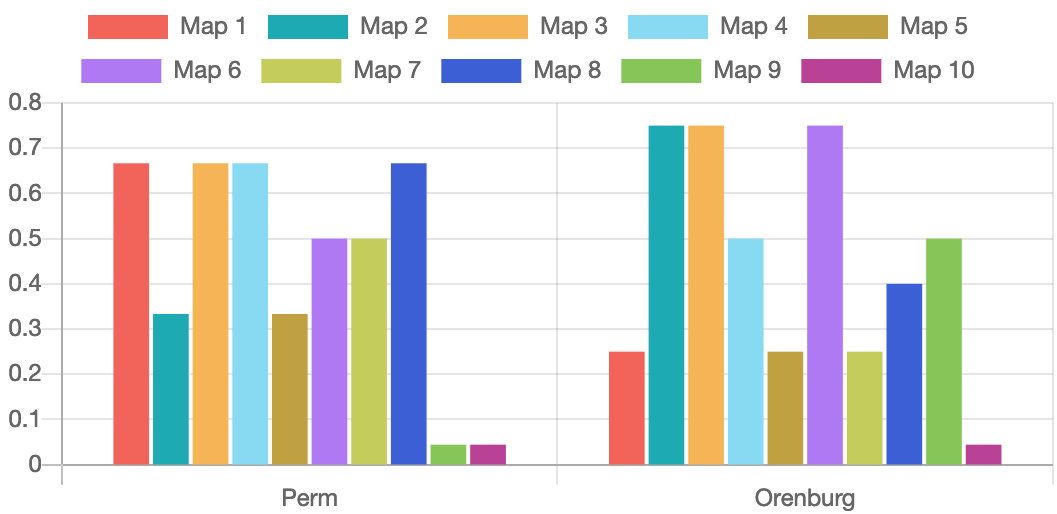
Fig. 7. Visualization of maps’ fuzzy classification results in SciVi
In this paper, we describe the Creative
Maps Studio application for digital mental mapping and the ways it can be used
to work with digital mental maps presented in a form of naive geographical
maps. Digital maps have a number of advantages over the traditional paper-drawn
ones, enabling researchers to benefit from the modern data mining methods by
analyzing different graphical and semantic properties of these maps. Such an
analysis is an essential part of the Digital Humanities research that targets
public mood in a certain region, features of human perception of the
surrounding regional space, etc.
We propose several approaches to visual
analysis of mental maps, involving Creative Maps Studio vector graphics editor,
SciVi data mining platform, and Semograph information system. This software
tools’ combination leverages a comprehensive study of the mental maps’
features, which can be extracted from the naive maps’ representations.
Currently, we carried out several
experiments based on mental maps’ analysis. The most significant ones, for now,
are the analysis of China maps drawn by the Chinese students, and the fuzzy
classification of Russian maps drawn by informants from Perm and Orenburg. The
experiments conducted shown the efficiency of the analytical pipelines
proposed. We can state, that digital naive maps composed in the Creative Maps
Studio appear to be adequate visualization of subjective geospatial
representations of a person and social groups, and the described software
combination is a viable toolkit for extracting information from the constructed
mental map models.
In the future, we plan to extend the number
of operators to analyze mental maps in SciVi and Semograph, as well as to
explore the ways of analyzing the history of maps’ objects manipulations within
Creative Maps Studio. Also, we plan to expand the set of objects available for
drawing the maps and implement the mechanism allowing researchers to create
custom map elements for particular needs.
This work was supported by Russian Science
Foundation (grant number 20-18-00336).
1.
Henrikson, A.K.
The Geographical “Mental Maps” of American Foreign Policy Makers.
International Political Science Review // Polytics and Geography. – 1980.
– Vol. 1, No. 4. – PP. 495–530.
DOI:
10.1177/019251218000100405.
2.
Zelianskaia, N.L., Belousov, K.I.,
Galinskaia, T.N., Ichkineeva, D.A. Naive Geography:
Geoconceptology and Topology of Geomental Maps // Heliyon. – 2020. – Vol.
6, Iss. 12.
DOI: 10.1016/j.heliyon.2020.e05644.
3.
Self, C.M.,
Gopal, S., Golledge, R.G., Fenstermaker, S. Gender-Related
Differences in Spatial Abilities // Progress in Human Geography. – 1992. –
Vol. 16, No. 3. – PP. 315–342.
DOI:
10.1177/030913259201600301.
4.
Kaplan, D.H.,
Herb, G.H. How Geography Shapes National Identities // National
Identities. – 2011. – Vol. 13, No. 4. – PP. 349–360.
DOI:
10.1080/14608944.2011.629424.
5.
Taylor, S.A.
Place Identification and Positive Realities of Aging // Journal of
Cross-Cultural Gerontology. – 2001. – No. 16. – PP. 5–20.
DOI: 10.1023/a:1010673000367.
6.
Saarinen, T.F.,
MacCabe, C.L. World Patterns of Geographic Literacy Based on Sketch
Map Quality // The Professional Geographer. – 1995. – Vol. 47, Iss. 2. –
PP. 196–204.
DOI: 10.1111/j.0033-0124.1995.00196.x.
7.
Didelon, C.,
de Ruffray, S., Boquet, M., Lambert, N. A World of Interstices:
A Fuzzy Logic Approach to the Analysis of Interpretative Maps // The
Cartographic Journal. – 2011. – Vol. 48. – PP. 100–107.
DOI: 10.1179/1743277411Y.0000000009.
8.
Blades, M.
The Reliability of Data Collected from Sketch Maps // Journal of
Environmental Psychology. – 1990. – Vol. 10, Iss. 4. – PP. 327–339.
DOI: 10.1016/S0272-4944(05)80032-5.
9.
Ryabinin, K.V.,
Belousov, K.I., Chuprina, S.I., Shchebetenko, S.A.,
Permyakov, S.S. Visual Analytics Tools for Systematic Exploration of
Multi-Parameter Data of Social Web-Based Service Users // Scientific
Visualization. – 2018. – Vol. 10, No. 4. – PP. 82–99.
DOI: 10.26583/sv.10.4.07.
10.
Lynch, K.
The Image of City. – 1960. – 197 p.
11.
Gould, P.R.
On Mental Maps. – 1966. – 106 p.
12.
Milgram, S.,
Jodelet, D. Psychological Maps of Paris // Environmental psychology:
People and their physical settings. – 1976. – PP. 88–113.
13.
Herman, J.F.
Children’s Cognitive Maps of Large-Scale Spaces: Effects of Exploration,
Direction, and Repeated Experience. – 1980. – Vol. 29, No. 1. – PP.
126–143.
DOI: 10.1016/0022-0965(80)90096-X.
14.
Evans, G.W.,
Marrero, D.G., Butler, P.A. Environmental Learning and Cognitive
Mapping // Environment and Behavior. – 1981. – Vol. 13, Iss. 1. – PP.
83–104.
DOI: 10.1177/0013916581131005.
15.
Gieseking, J.J.
Where We Go from Here: The Spatial Mental Mapping Method and Its Analytic
Components // Qualitative Inquiry. – 2013. – Vol. 19, No. 9. – PP.
712-724.
DOI: 10.1177/1077800413500926.
16.
White, R.J.,
Green, A.E. The Use of Mental Maps in Youth Research: Some Evidence
from Research Exploring Young People’s Awareness of and Attachment to
Place // Innovations in Youth Research. – 2012. – PP. 58-76.
DOI:10.1057/9780230355880_4.
17.
Waterman, S.,
Gordon, D. A Quantitative-Comparative Approach to Analysis of
Distortion in Mental Maps // Professional Geographer. – 1984. – Vol. 36,
No. 3. – PP. 326-337.
DOI:
10.1111/j.0033-0124.1984.00326.x.
18.
Aram, F.,
Solgi, E., García, E.H., Mohammadzadeh, D.,
Mosavi, A., Shamshirband, S. Design and Validation of a
Computational Program for Analysing Mental Maps: Aram Mental Map Analyzer
// Sustainability. – 2019. – Vol. 11, No. 14. – DOI: 10.3390/su11143790.
19.
Appleyard, D.
Styles and Methods of Structuring a City // Environment and Behavior. –
1970. – Vol. 2, No. 1.
PP. 100–117.
DOI:10.1177/001391657000200106.
20.
Tobler, W.R.
Bidimensional Regression // Geographical Analysis. – 1994. – Vol. 26, No.
3.
PP. 187–212. DOI:
10.1111/j.1538-4632.1994.tb00320.x.
21.
Gardony, A.L.,
Taylor, H.A., Brunyé, T.T. Gardony Map Drawing Analyzer:
Software for Quantitative Analysis of Sketch Maps // Behavioral Research
Methods. – 2015. – Vol. 48, No. 1. – PP. 151–177.
DOI:
10.3758/s13428-014-0556-x.
22.
Dubois, D.,
Prade, H., Testemale, C. Weighted Fuzzy Pattern Matching //
Fuzzy Sets and Systems. – 1988. – Vol. 28, No. 3. – PP. 313–331.
DOI:10.1016/0165-0114(88)90038-3.
23.
Ryabinin, K.,
Chuprina, S. Development of Ontology-Based Multiplatform Adaptive
Scientific Visualization System // Journal of Computational Science. –
2015. – Vol. 10. – PP. 370–381.
DOI:
10.1016/j.jocs.2015.03.003.
24.
Belousov, K.,
Erofeeva, E., Leshchenko, Y., Baranov, D. “Semograph”
Information System as a Framework for Network-Based Science and Education
// Smart Innovation, Systems and Technologies.
Smart
Education and e-Learning. – 2017. – PP. 263–272. DOI:
10.1007/978-3-319-59451-4_26.
25.
Ryabinin, K.V.,
Belousov, K.I., Chuprina, S.I. Novel Circular Graph Capabilities
for Comprehensive Visual Analytics of Interconnected Data in Digital
Humanities // Scientific Visualization. – 2020. – Vol. 12, No. 4. – PP.
56–70.
DOI: 10.26583/sv.12.4.06.
26.
Baranov, D.,
Belousov, K., Erofeeva, E., Leshchenko, Y. Semograph
Information System as a Platform for Network-Based Linguistic Research: A
Case Study of Verbal Behavior of Social Network Users // Springer. – 2019.
– Vol. 144. – PP. 313–324.
DOI:
10.1007/978-981-13-8260-4_29.
27.
Zelyanskaya, N.,
Galinskaia, T., Belousov, K. Vladimir Putin’s Image of the
World: ‘Apophatic' Thinking as a Political Principle // International
Multidisciplinary Scientific Conference on Social Sciences and Arts
SGEM2014. – 2014. – B. 2, Vol. 1. – PP. 483–490.
DOI:
10.5593/sgemsocial2014/B21/S4.064.
28.
Ryabinin, K.V., Belousov, K.I., Chumakov, R.V.
Ontology-Driven Data Mining Platform for Fuzzy Classification of Mental
Maps // Frontiers in Artificial Intelligence and Applications. – Accepted
for publication in 2021.







